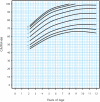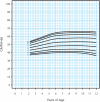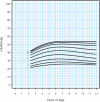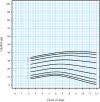Reference curves for the Gross Motor Function Measure: percentiles for clinical description and tracking over time among children with cerebral palsy
- PMID: 18339799
- PMCID: PMC2390723
- DOI: 10.2522/ptj.20070314
Reference curves for the Gross Motor Function Measure: percentiles for clinical description and tracking over time among children with cerebral palsy
Abstract
Background and purpose: Physical therapists frequently use the 66-item Gross Motor Function Measure (GMFM-66) with the Gross Motor Function Classification System (GMFCS) to examine gross motor function in children with cerebral palsy (CP). Until now, reference percentiles for this measure were not available. The aim of this study was to improve the clinical utility of this gross motor measure by developing cross-sectional reference percentiles for the GMFM-66 within levels of the GMFCS.
Subjects and methods: A total of 1,940 motor measurements from 650 children with CP were used to develop percentiles. These observations were taken from a subsample, stratified by age and GMFCS, of those in a longitudinal cohort study reported in 2002. A standard LMS (skewness-median-coefficient of variation) method was used to develop cross-sectional reference percentiles.
Results: Reference curves were created for the GMFM-66 by age and GMFCS level, plotted at the 3rd, 5th, 10th, 25th, 50th, 75th, 90th, 95th, and 97th percentiles. The variability of change in children's percentiles over a 1-year interval also was investigated.
Discussion and conclusion: The reference percentiles extend the clinical utility of the GMFM-66 and GMFCS by providing for appropriate normative interpretation of GMFM-66 scores within GMFCS levels. When interpreting change in percentiles over time, therapists must carefully consider the large variability in change that is typical among children with CP. The use of percentiles should be supplemented by interpretation of the raw scores to understand change in function as well as relative standing.
Figures






References
-
- Rosenbaum PL, Paneth N, Leviton A, et al. A report: the definition and classification of cerebral palsy April 2006 [erratum appears in Dev Med Child Neurol Suppl. 2007;49:480]. Dev Med Child Neurol Suppl. 2007;109:8–14. - PubMed
-
- Stanley FJ, Blair E, Alberman E. Cerebral Palsies: Epidemiology and Causal Pathways. London, United Kingdom: MacKeith Press; 2000.
-
- Who are physical therapists and what do they do? In: Guide to Physical Therapist Practice. 2nd ed. Phys Ther. 2001;81:31–42.
-
- Rosenbaum PL, Walter SD, Hanna SE, et al. Prognosis for gross motor function in cerebral palsy: creation of motor development curves. JAMA. 2002;288:1357–1363. - PubMed
-
- Palisano RJ, Rosenbaum PL, Walter SD, et al. Development and reliability of a system to classify gross motor function in children with cerebral palsy. Phys Ther. 1997;39:214–223. - PubMed
Publication types
MeSH terms
Grants and funding
LinkOut - more resources
Full Text Sources
Other Literature Sources
Medical
Miscellaneous

